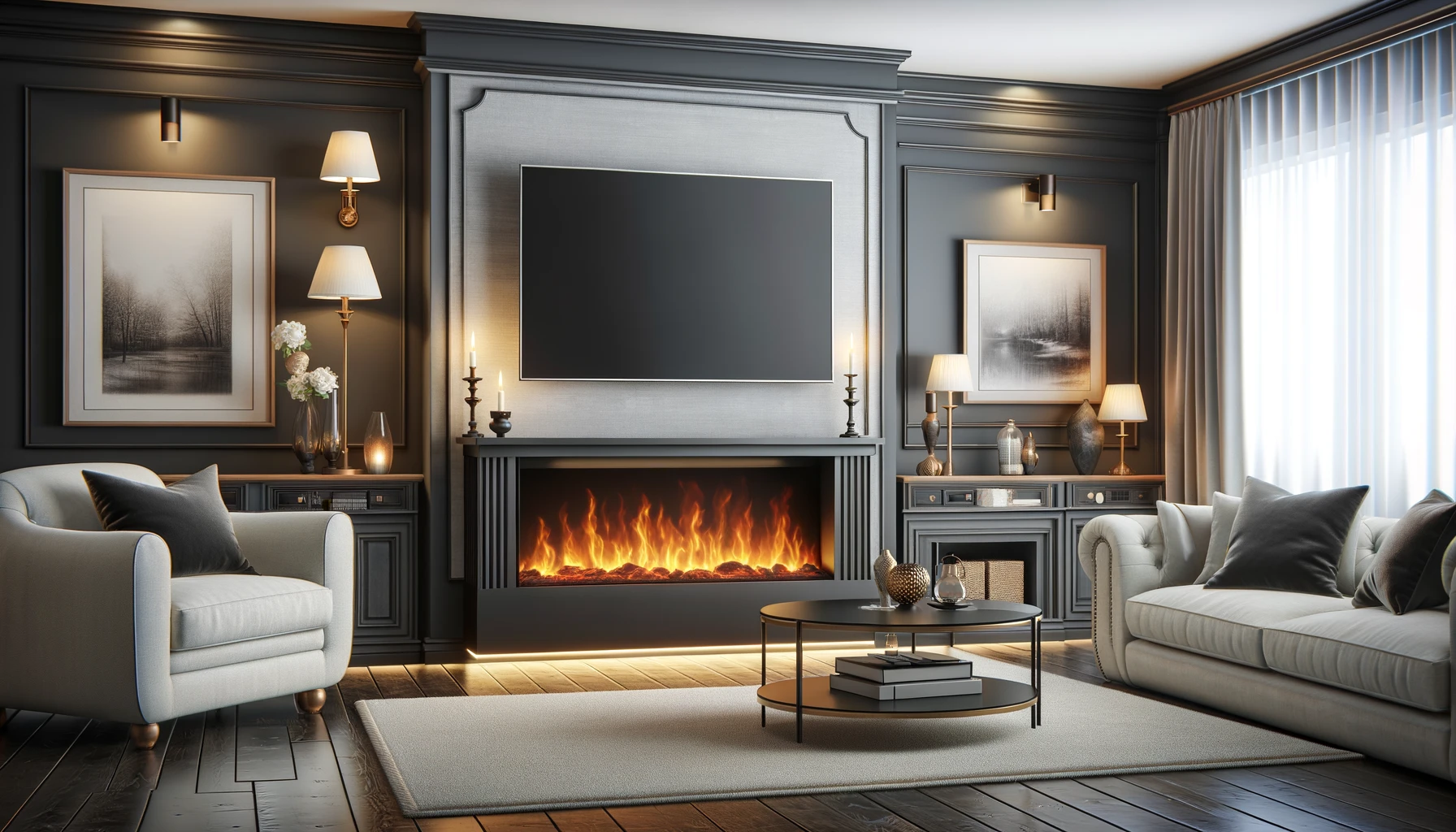Are TV Stand Fireplaces Safe for Your Home?
Have you ever wondered, “Are TV stand fireplaces safe?” If so, you’re not alone.
Many people want to combine warmth and entertainment without compromising safety.
While these fireplaces can add ambience and practicality to your living room, keeping your TV and home secure requires knowing a few essential tips and choosing the right model.
In this guide, we’ll walk you through key precautions like proper installation, ventilation, and heat management .
You’ll also learn how to select the best TV stand fireplace that fits your room layout and heating needs.
By understanding the specific risks and how to mitigate them, you can confidently enjoy the glow of a TV stand fireplace without worry.
Stay with us to find out how to protect your electronics, pick quality brands, and ensure a safe, efficient setup.
Understanding TV Stand Fireplaces
TV stand fireplaces are gaining popularity for their ability to combine heating and entertainment in one stylish unit.
Here’s a breakdown of their features and why they stand out:
| Feature | Explanation |
| Electric Heating | These units use efficient electrical heating elements to create warmth safely. |
| Flame Display | LED lights mimic flames, providing the aesthetic of a traditional fireplace. |
| Dual Functionality | Serves as both an entertainment stand and a supplemental heat source. |
| Adjustable Settings | Heat and flame intensity can be adjusted for optimal comfort. |
Types of Heaters
- Fan-Forced Heat: This is a traditional design using coils and a fan to blow warm air through the room. Effective for heating up to 400 sq. ft., these units provide supplemental warmth.
- Infrared Heat: Infrared models are energy-efficient and can heat up to 1,000 sq. ft. They warm both air and objects in the room without making surfaces excessively hot.
Safety Features and Considerations
- Ventilation: Ensure adequate airflow around the unit and avoid blocking the vents to prevent overheating
- Heat Management: “Maintaining at least six inches of clearance between the TV and the fireplace is crucial,” .
- Heat Shield: Consider adding a mantel or heat shield to redirect heat away from the TV
Choosing the Right Model
When picking the best fireplace TV stand, consider:
- Brand Reputation: Look for trusted brands that offer warranties and customer support.
- Size and Design: Choose a model that matches your TV size and room layout.
- Heat Output: Assess BTU ratings to determine the unit’s ability to warm your space effectively.
A pro tip from MagikFlame suggests, “Check the manufacturer’s guidelines for each model, as modern high-quality units are designed with electronics in mind”.
By understanding these core features and safety practices, you can find a fireplace TV stand that suits your home while ensuring a warm and secure entertainment area.
Safety Precautions for TV Stand Fireplaces
Using a TV stand fireplace requires adopting some safety precautions to keep your home and electronics secure.
Here’s a guide to help you maintain a safe setup while enjoying the warmth:
| Precaution | How to Implement |
|---|---|
| Electrical Safety | Plug directly into a grounded outlet and avoid overloading circuits. |
| Heat Management | Maintain at least six inches between the TV and the unit. |
| Ventilation | Ensure vents are clear to prevent overheating. |
| Supervision | Don’t leave the fireplace unattended for long periods. |
| Heat Shield | Consider a mantel or heat shield to redirect heat away from the TV. |
Electrical Safety
- Grounded Outlet: “Ensure the TV stand fireplace is plugged into a grounded outlet,” states the Fireplace Adviser. Using an extension cord may overload circuits and create a fire hazard.
- Manufacturer Guidelines: Always follow manufacturer instructions for proper setup. “Check the unit’s manual for specific electrical requirements,” advises Hazloez.
Ventilation and Heat Management
- Ventilation: Adequate airflow prevents overheating. Make sure vents are unobstructed to allow heat to dissipate properly.
- Heat Clearance: Maintain six inches of clearance between the TV and fireplace to prevent excessive heat exposure. Eagle TV Mounting recommends “placing a mantel or heat shield to redirect heat away from sensitive electronics”.
Supervision and Regular Maintenance
- Monitoring: Keep a thermometer handy to monitor heat levels. The glass can become hot, and the unit should not be left on without supervision.
- Maintenance: Dust or debris can accumulate, affecting performance. “Check the fireplace for signs of wear, and clean it regularly to maintain optimal performance,” suggests.
Adhering to these precautions ensures that your fireplace TV stand provides cosy warmth while keeping your TV safe.
Quote: “With proper planning and care, you can safely enjoy your fireplace TV stand,” says Electric Fireside.
Make sure you ground the unit, manage heat effectively, and follow supervision guidelines for secure and warm entertainment.
Choosing the Right TV Stand Fireplace
When choosing a TV stand fireplace, it’s essential to consider features that will ensure safe and efficient heating while complementing your home décor.
Here’s a step-by-step guide to help you make an informed choice:
1. Assessing Your Room Layout
- TV Size and Position: Measure your TV size to find a stand that fits your room layout. Hazloez suggests, “Maintain a six-inch gap between the TV and fireplace for effective heat management”.
- Room Size: Ensure the fireplace’s heat output matches your room’s dimensions. A smaller unit won’t sufficiently warm large rooms, while an overly powerful one may overheat a smaller space.
2. Selecting the Heating Type
- Fan-Forced Heaters: Great for small rooms up to 400 sq. ft. They use fans to distribute heated air.
- Infrared Heaters: Suitable for large areas up to 1,000 sq. ft., these heaters provide efficient, even warmth.
| Feature | Fan-Forced Heaters | Infrared Heaters |
|---|---|---|
| Coverage | Up to 400 sq. ft. | Up to 1,000 sq. ft. |
| Energy Efficiency | Moderate | High |
| Heat Distribution | Direct warm air | Warms air and surrounding objects |
| Best For | Small rooms | Larger rooms or open spaces |
3. Style and Design Options
- Flame Effects: Look for LED flame displays that simulate the glow of a real fire.
- Material and Finish: Choose durable materials like engineered wood that align with your interior design.
- Storage and Extra Features: Find models with adjustable shelves for electronic storage and remote control for convenient operation.
4. Safety Features
- Ventilation and Overheat Protection: Ensure the unit includes an auto-shutoff feature to prevent overheating.
- Heat Shield or Mantel: Add a heat shield to deflect heat away from the TV.
“Stick with brands that offer clear safety instructions and warranties,” advises Hazloez.
5. Budget and Warranty
- Budget: Find models within your budget but still prioritize essential safety features.
- Warranty: Go for brands with strong warranty policies to guarantee quality and customer support.
Finding the right TV stand fireplace means balancing style, functionality, and safety.
By carefully considering heating type, layout, and safety features, you can enjoy a warm and safe living space.
To conclude
TV stand fireplaces can be a stylish and functional addition to your home, but ensuring safety and efficiency requires thoughtful planning. Here’s a recap of key points:
Prioritizing Safety
Electrical Precautions: Plug directly into a grounded electrical outlet, avoiding extension cords.
Hazloez states, “Always follow manufacturer guidelines to prevent overloading circuits”.
Ventilation and Clearance: Maintain six inches of clearance between the TV and fireplace.
Choosing the Right Model
Heating Types: Choose fan-forced heaters for smaller spaces and infrared heaters for larger rooms up to 1,000 sq. ft. Flame Effects: LED lights offer realistic flame displays without generating excessive heat.
Optimizing Efficiency
Adjustable Heat: Select models with adjustable heat settings to match your desired warmth level. Energy Savings: These fireplaces are cost-effective, providing supplemental heat and reducing reliance on central HVAC systems. Feature Benefit Infrared Heaters Efficiently warm up to 1,000 sq. ft.
Fan-Forced Heaters Provide consistent warmth in small rooms LED Flame Effects Simulate realistic fire for ambiance Heat Management Adjustable heat settings: “With the right precautions, a TV stand fireplace can add warmth and safety to your entertainment setup,” says hazloez .
Final Checklist
Warranty: Choose brands with comprehensive warranty policies for quality assurance.
Maintenance: Regularly clean vents and check for signs of wear and tear.
Summary When selecting a TV stand fireplace, prioritize safety, fit your room layout, and choose features that align with your needs. By following these steps, you’ll enjoy a cozy and secure entertainment experience.
Frequently Asked Questions (FAQs) about TV Stand Fireplaces
1. How long can you leave a TV stand fireplace on?
- It’s recommended to follow the manufacturer’s guidelines for maximum usage time. Typically, electric fireplaces can run for several hours, but they shouldn’t be left unattended for long periods or overnight.
2. Do TV stand fireplaces get hot to touch?
- The heating element or front glass can become warm, especially with high-output models. Infrared heaters distribute heat evenly without making surfaces too hot, but fan-forced models could have hotter surfaces.
3. Is it safe to put a TV under an electric fireplace?
- It can be safe as long as there’s adequate clearance and proper heat shielding. Ensure your setup maintains six inches between the TV and the fireplace, and use a mantel or heat deflector if needed.
4. Do TV stand fireplaces use a lot of electricity?
- Most electric fireplaces use between 750 and 1,500 watts per hour, depending on heat settings. Models with LED flames consume less energy than those providing full heating.
5. Is it safe to leave a fireplace on all night?
- No, it’s not advisable to leave any heating device running unattended overnight. Turn the unit off before going to bed or leaving the house to prevent overheating risks.
6. Are fireplace TV stands safe on carpet?
- Electric fireplace TV stands can be placed on carpeted floors if they are securely grounded. Ensure that there’s proper airflow to prevent heat buildup and minimize risks.
7. How hot is too hot for a TV above a fireplace?
- Most TVs can’t handle more than 100°F without risking screen damage. Use an infrared thermometer to monitor temperatures, keeping it below this level.
8. Where should I put my TV stand in my living room with a fireplace?
- Place the stand in a way that allows airflow around the fireplace, ensuring the TV is six inches above or away from the heat source to prevent overheating and provide a comfortable viewing angle.
9. Can you put a fireplace in any TV stand?
- Not all TV stands can support a fireplace. Choose a stand that is designed for electric fireplaces, offering proper ventilation and storage for your electronics.
10. Is it safe to leave an electric fireplace on all day?
- While most units are equipped with safety features, it’s better to turn off the unit when not in use or unattended. Use an automatic timer or a smart plug for safer use.
11. How long can you leave a wood fireplace on?
- A wood fireplace should only be left on while actively monitored. Never leave a fire burning overnight or when not present.
12. How much does it cost to run a TV stand fireplace?
- Electric fireplaces generally cost around £0.10 to £0.20 per hour, depending on local electricity rates and heater wattage.
13. How much heat can a TV withstand?
- TVs are typically designed to handle temperatures up to 100°F safely. Excessive heat can cause internal components to overheat and fail. Ensure proper ventilation is maintained.
Remember to always follow the manufacturer’s guidelines for your specific model and ensure proper ventilation, clearance, and supervision for a safe, warm environment.











